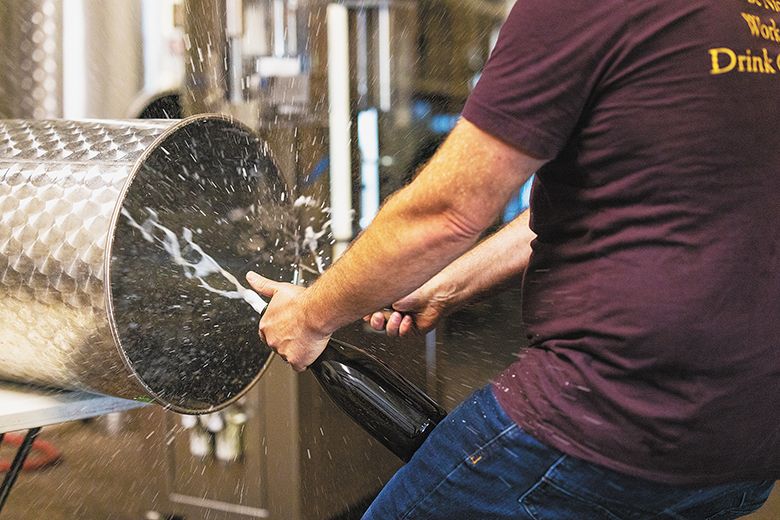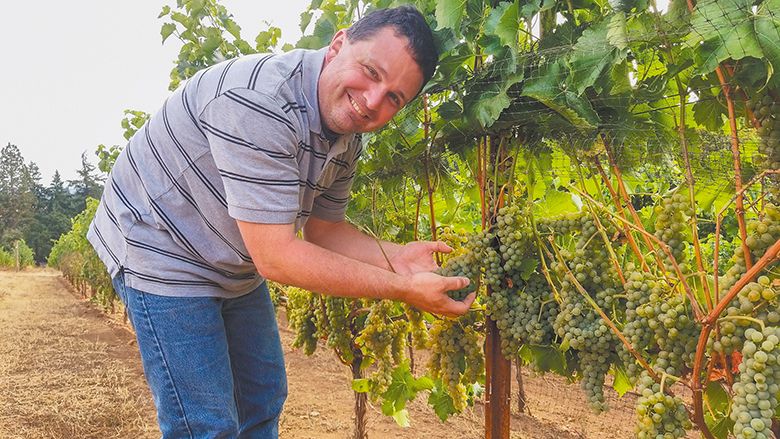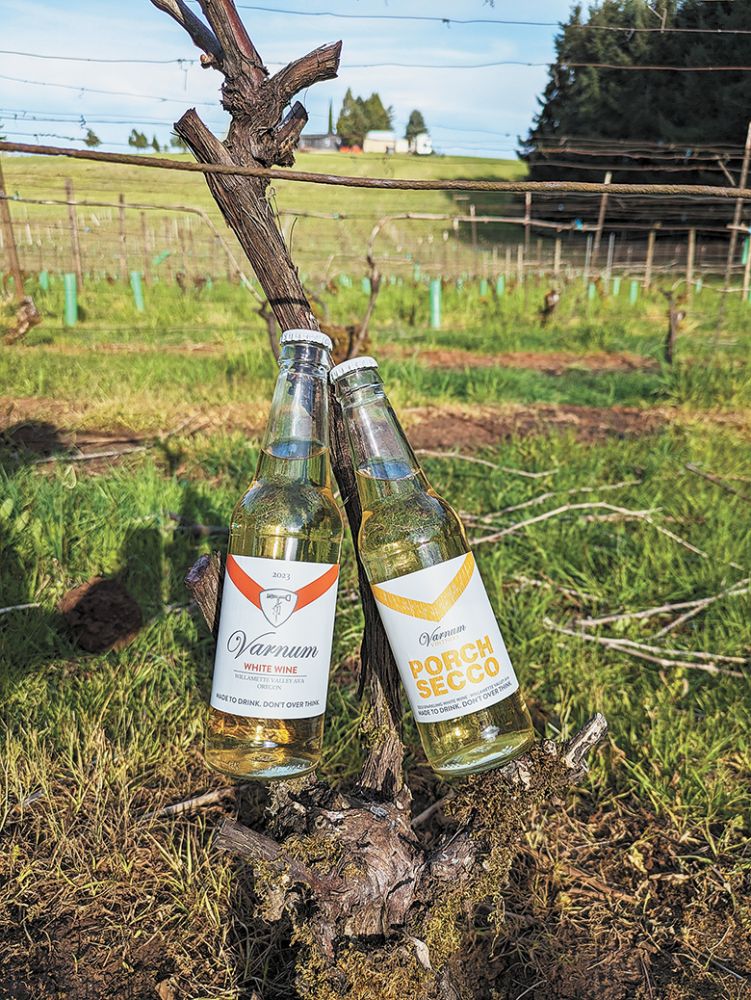Méthode Untraditionnelle
Untraditional sparkling wines and the inspiration behind them



By Tamara Turner
In a place where Pinot Noir and Chardonnay are internationally lauded, it’s no surprise sparkling wine production has followed suit. Proof lies in the recent explosion of Oregon’s sparklers with these traditional grape varieties. Yet, some local producers are using “un-Champagne” grapes, creating effervescent delights rivaling those from the Old World.
From Malbec to Müller-Thurgau, Pinot Blanc to Seyval Blanc, and countless other unique varieties, Oregon winemakers have transformed a range of grapes into sparkling wonders showcasing the unique terroir of the Pacific Northwest. Let’s review some of them.
Making Old New Again
Champagne is famous for its strict laws and centuries-old traditions of crafting sparkling wine from three grape varieties— Pinot Noir, Chardonnay and Pinot Meunier. However, prior to the 19th century, traditional planting practices in Champagne favored a wide mix of vines. In addition to the “big three,” other varieties, including Pinot Gris, Pinot Blanc, Arbane, and Petit Meslier were also used.
After a century of controlled regulation, Michael Lundeen, owner and winemaker of Lundeen Wines, wondered about those other grapes. “It’s an important reason why I began using Pinot Gris for sparkling wine in the first place,” he says. “By 2019, when I made my first Blanc de Gris, few knew how traditional method Pinot Gris tasted.” With no comparison, Lundeen relied on how he imagined it should taste.
After more than two decades working with fruit grown at his family’s Poverty Bend Vineyard, Lundeen believes he finally unlocked the grape’s code. “Using Pinot Gris in sparkling has great potential– it really shows the terroir,” he declares. “After committing to using it in my sparkling program, I discovered an elevated version.”
He believed since the grape is nearly a fraternal twin to Pinot Noir, it should perform similarly. “Pinot Gris is delicious on its own and has become a great point of entry for broader conversations about varieties and their possibilities. It’s especially important in this area– where Pinot Gris has gone through booms and busts.”
Crafting traditional method, or Méthode Champenoise, sparkling wine is a labor-intensive, time-consuming endeavor requiring precision and patience. After grapes are harvested and pressed, the juice undergoes primary fermentation to create a base wine. It is then bottled with a mixture of yeast and sugar, triggering a second fermentation within the bottle, producing the bubbles. Eventually, the lees, a result of the bottle ferment, are removed, and each bottle is topped up and finished with a cork and cage closure.
Lundeen makes still and sparkling Pinot Gris wines separately. Both are barrel-aged and neither receive sulfur at pressing. However, the base wine for his sparkling is whole-cluster-pressed, contributing weight and texture, making it somewhat richer. His still Pinot Gris is partially to fully destemmed before pressing, depending on the vintage. Lundeen also uses the grape in his flagship wine, NV Brut.
He experiments with other grape varieties, like his Muscat Blanc à Petit Grains. Unlike sweet, fizzy, yet pretty Moscato, Lundeen Wines’ sparkling Muscat is dry. “I sourced cuttings of a superior clone that ripens later than Muscat Ottonel. It’s more elegant,” says Lundeen. Muscat, so effusive aromatically, doesn’t require fermentation and yeast to produce the aroma. “The grapes smell beautiful from Day One. I give it a classy boost by using the traditional method to transform it into a sparkling wine.”
Jeanne Feldkamp, co-owner and co-winemaker at Corollary Wines, also embraces Champagne’s past with a sparkling Pinot Blanc. Focused solely on sparkling wines, she says, “Pinot Blanc creates wines with great verve, racy acidity, freshness and bright minerality— all wonderful qualities for sparkling.”
Dedicated to Oregon’s Willamette Valley, and particularly its expression in sparkling wine, Feldkamp finds Pinot Blanc especially reflective of terroir. “Within the Valley, we find great differences between different vineyards,” says Feldkamp. “Some are more steely, some more tropical, some more delicate, and some higher in acid. The fruit in our sparkling Pinot Blanc from Winter’s Hill Vineyard is very transparent, showing the minerality you get from a high-elevation site.”
Feldkamp explains how Oregon Pinot Blanc ripens later than the Dijon clones of Pinot Noir. This contributes acid, minerality, and floral notes, making exciting single vineyard wines and adding complexity to Feldkamp’s blends. The sparkling Pinot Blanc is quite different from Corollary’s other wines. “On the nose, our Winter’s Hill Pinot Blanc is light and ethereal with notes of Asian pear and white flowers. The palate is crisp and fresh, delivering lime zest and a hint of wet stone,” describes Feldkamp. “In contrast, our Chardonnay-based Blanc des Blancs tend to be richer on the palate. The X-Omni Blanc des Blancs delivers layers of citrus, toasted hazelnut and almond, whereas the Namaste Blanc des Blancs is tropical and a bit spicy with notes of pineapple, ginger and baking spices.”
Corollary opened its much-anticipated tasting room last month in the Eola-Amity Hills of the Willamette Valley. The stunning interior and exterior spaces include curated, immersive winemaker tastings dedicated exclusively to sparkling wine.
Defying Tradition
When Dave Specter, owner and winemaker of Bells Up Winery, planted his vineyard in the Willamette Valley, he included hybrid grape Seyval Blanc, popular on the East Coast. “If you’re going to play around with different varieties in the Willamette Valley, it’s easier to do with whites. Plus, I had a history with it,” says Specter. He won his first amateur wine competition with Seyval Blanc. But he never thought he’d turn it into sparkling wine.
Bells Up Winery started commercially producing Seyval Blanc’s “Helios” in 2018. “Back then, I repeatedly said we’d never make sparkling of any kind. I wasn’t convinced I could make one that would stand out in the Valley,” admits Specter. But in 2022, things changed.
“I’d love to say I had some grand inspiration for creating a sparkling Seyval Blanc, but in reality, it was born out of necessity,” observes Specter. With excess fruit, Specter assumed selling any would be difficult since the variety is quite unusual in Oregon. A friend suggested making it into sparkling wine. “As I did more research, I discovered sparkling Seyval Blanc is fairly common in the U.K. and can also be found in New York’s Finger Lakes region. At that point, I figured it was worth a try,” says Specter.
Bells Up harvests their estate-grown Seyval Blanc all at once. As a small winery, two picks that small is neither commercially nor practically feasible. Specter presses and ferments the entire batch in a single tank. Once fermentation is complete, he stirs the lees a few times each week for six months, building a creamy texture critical for both the still and sparkling versions.
“Side-by-side tastings are a really fun way to show customers the impact the bubbles make,” says Specter. “Most people can’t believe the two wines come from the exact same batch– the nose and palate are very different between the two.”
Kramer Vineyards is recognized for its sparkling Müller-Thurgau, and rightfully so. But sparkling Grüner Veltliner? Winemaker Kim Kramer says emphatically yes. Kramer first produced Grüner Veltliner in 2014. It was their first harvest of the grape, but Kramer wasn’t even sure they’d pick it. “But we harvested a ton, enough to justify not blending it with something else,” she explains. “At that time, I was preoccupied with sparkling everything I could get my hands on. Plus, the sugar/acid ratio was perfect for a sparkling wine.”
For Kramer, exploring non-traditional winemaking methods with sparkling wine grapes makes sense. Many of Kramer’s sparkling wines are force-carbonated. “When I first started making bubbles, I experimented with traditional methods, including Pét-nat, but disliked most of them,” observes Kramer. “Carbonating produces extra fruit expression and clarity than we’d otherwise achieve; it’s just better suited to many of the grapes we work with.”
Ready-to-Drink UnChampagne
With a reputation for being both innovative and creative, Varmun Vintners receives increasing recognition for its high-quality beverages in small, portable bottles. Making both a still and sparkling white blend, owner and winemaker, Cyler Varnum, says, “It’s not necessary to pay a premium for sparkling wine. Ours is volumetrically economical in half bottles. It’s stylish too; you can drink it straight from the bottle.”
The Varnum Vintners brand initially embraced only classic packaging. “When we first put wine in a beer bottle, we didn’t plan to take the whole brand with it,” says Varnum. “But now, I want to be known as the wine-in-a-beer-bottle guy.” Varnum’s mission is to make wine more casual, and with a wider range of styles.
Enter Varnum’s Porch wines, modeled after the sparkling wines of the world. Varnum is convinced there’s value in showcasing the Willamette Valley’s potential with the expression of sparkling from around the world. “They are honest versions of Lambrusco and Prosecco… yet, also distinctly Oregon, showcasing the diversity of the Valley,” says Varnum. “We can either harp on tradition or choose to explore an innovative side.”
Varnum’s PorchSecco is a drier, more serious, approachable white with a minerality like classic Prosecco. Varnum believes people want the simplest way to understand a wine, so he removes pretension from the equation. “Saying it’s our version of Prosecco is easier than explaining it’s made with 25 different grapes.
It sounds like a kitchen sink blend, but is meant to showcase a consistent expression of Varnum Brut,” explains Varnum. “Our Brut should always be crisp, citrusy, and a bit savory, mimicking the house style of Champagne. If you’re drinking Dom, Veuve or Varnum, all have a recognizable style that’s comforting and predictable.”
The still version of the wine is richer before bubbles are introduced. After force-carbonation, the identical base wine tastes significantly different. Varnum uses the traditional method for some of his other wines. The result? A sparkling wine and true reflection of Oregon’s terroir– bright acidity, crisp fruit flavors and a delicate mousse that dances on the palate. Each sip represents a celebration of our unique climate and soil, showcasing not only the diversity of non-Champagne grapes but also the skill of the winemaker.
A story hunter at heart, Tamara Belgard Turner is a freelance journalist focused on uncovering interesting and educational stories in the wine and travel industries. WSET2 certified, she passionately writes about wine, spirits, food and travel for a variety of lifestyle and wine publications. One of her favorite pastimes is locating and sharing information about hidden wine gems.










